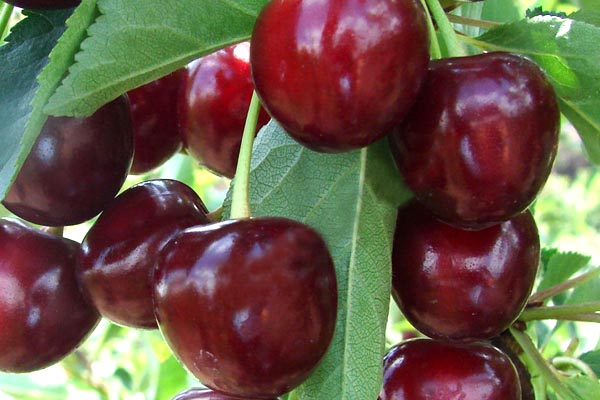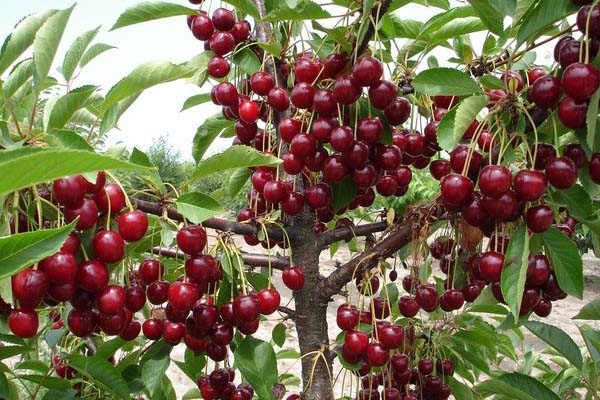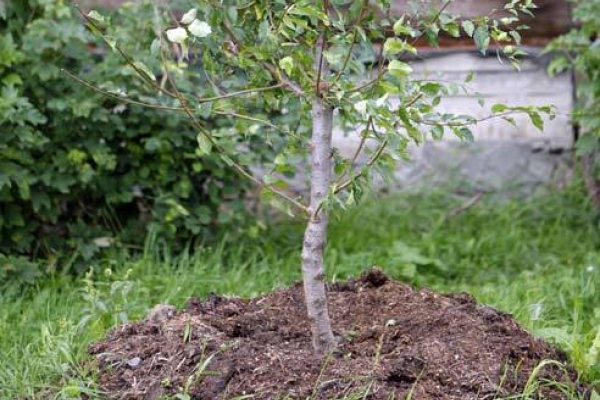Cherry Turgenevskaya: description of the variety and agricultural technology
Description
All varieties of cherries are highly valued by gardeners for the high quality of fruits and their nutritional value. Cherry fruits contain vitamins B9 and B2, as well as iron, organic and bioactive substances. One of the excellent varieties of cherries is Turgenevskaya. It was obtained by selecting seedlings in the course of free pollination from the well-known Zhukovskaya cherry variety. If we talk about the description of this variety, it should be noted that Turgenevskaya cherry (otherwise also sometimes called Zhukovskaya) is a tree 3 m high, has a reverse pyramidal crown of medium density. Its shoots are of medium length, straight, brownish brown.
The bark on the main cherry branches is characterized by a grayish-brown hue. The leaves are narrow oval, shiny, dark green in color, and the buds are cone-shaped. The top of the tree, obtained by the All-Russian Research Institute of Breeding of Fruit Crops from the Zhukovskaya variety, is strongly walled, and the jaggedness of the edge is double-serrated. The cherry stalk of this variety is about 21 mm long and has an anthocyanin color. Corolla diameter is 24.1 mm, and the number of flowers per inflorescence is about four. White petals touch each other. The shape of the calyx is cup-shaped, and the length of the pistil of this tree is about 7, 9 mm, and the number of stamens is the same. The fruits of this tree are broad-hearted and dark red in color. The weight of cherries of this variety is approximately 5 g. The pulp is characterized by density and dark red color, and the stone is oval, it is creamy and is quite easy to separate. You can also easily tear the fruit off the stalk. This variety has a sweet and sour taste, and the amount of soluble substances in fruits is about 16%, sugars are present 11, 17%, acids - 1, 51%. The Turgenevskaya cherry variety blooms somewhere until mid-May, and the fruits begin to ripen in the first half of July. It is worth considering the fact that this type of tree is capable of bearing fruit only five years after planting in the garden. In terms of yield, this variety is considered good enough, the maximum number of fruits can be up to 200 centners per hectare. Turgenev cherry is able to withstand winter frosts quite normally.
The fruits of this tree are broad-hearted and dark red in color. The weight of cherries of this variety is approximately 5 g. The pulp is characterized by density and dark red color, and the stone is oval, it is creamy and is quite easy to separate. You can also easily tear the fruit off the stalk. This variety has a sweet and sour taste, and the amount of soluble substances in fruits is about 16%, sugars are present 11, 17%, acids - 1, 51%. The Turgenevskaya cherry variety blooms somewhere until mid-May, and the fruits begin to ripen in the first half of July. It is worth considering the fact that this type of tree is capable of bearing fruit only five years after planting in the garden. In terms of yield, this variety is considered good enough, the maximum number of fruits can be up to 200 centners per hectare. Turgenev cherry is able to withstand winter frosts quite normally.
Advantages
The fruits of this variety have bactericidal properties, therefore they are quite successfully used in medicine and cosmetology. It is absorbed quickly enough, has a positive effect on the cardiovascular system, reduces blood clotting. Cherries are a favorite treat for both adults and children. Indeed, as mentioned above, its fruits contain many micro- and macroelements necessary for the health of the human body, including magnesium, calcium, potassium, iron, copper, phosphorus. Among the vitamins that fruits, in particular, and Turgenevka, are rich in, is folic acid, which is indispensable for everyone. This wonderful variety received the greatest popularity and many fans in central Russia, since the tree is not too capricious - it tolerates very well both temperature changes and the presence of atmospheric precipitation, gives a generous harvest, is not particularly prone to unpleasant fungal diseases (moniliosis and commycosis ).
In addition to eating delicious fruits in their pure form, it is widely used to make jams, jams, fruit drinks, compotes, berry wine. In addition, you can freeze berries, as well as dry them for the winter, so that later you can also cook delicious compotes or add cherries to baked goods.
Specificity of care
The quality and quantity of the future harvest of Turgenevskaya cherry (obtained from Zhukovskaya) will directly depend on whether you take into account all its cultivation features. A very important point when planting is the choice of soil. One is needed where the amount of groundwater will not exceed one and a half meters. The acidity of the soil should be neutral.
The best soil for planting is sandy loam, but before planting a tree, it is recommended to add humus, superphosphate and potassium chloride fertilizers to the soil, as well as wood ash.
If the cherries are planted in clay soil, they should be poured into the holes in a bucket of sand. To protect the tree from unwanted weeds, after planting it is necessary to make a hole near the trunk. Mulching has also worked well. In order to prevent the soil from drying out, sufficient watering must be ensured in the first year.  One should not forget about feeding, for this, bird or cow droppings are used once a year. Experts advise fertilizing in several stages - in the spring, after the flowering period and in the middle of summer (when the tree bears fruit). Loosening of the soil must be done superficially. If, despite all the measures taken, weeds still appear, they must be weeded out. If there are signs of a disease, the tree should be carefully treated with a special preparation.
One should not forget about feeding, for this, bird or cow droppings are used once a year. Experts advise fertilizing in several stages - in the spring, after the flowering period and in the middle of summer (when the tree bears fruit). Loosening of the soil must be done superficially. If, despite all the measures taken, weeds still appear, they must be weeded out. If there are signs of a disease, the tree should be carefully treated with a special preparation.
Cherry Planting Video
On the recording, a woman talks about how to plant cherries correctly and how to care for a young tree.
